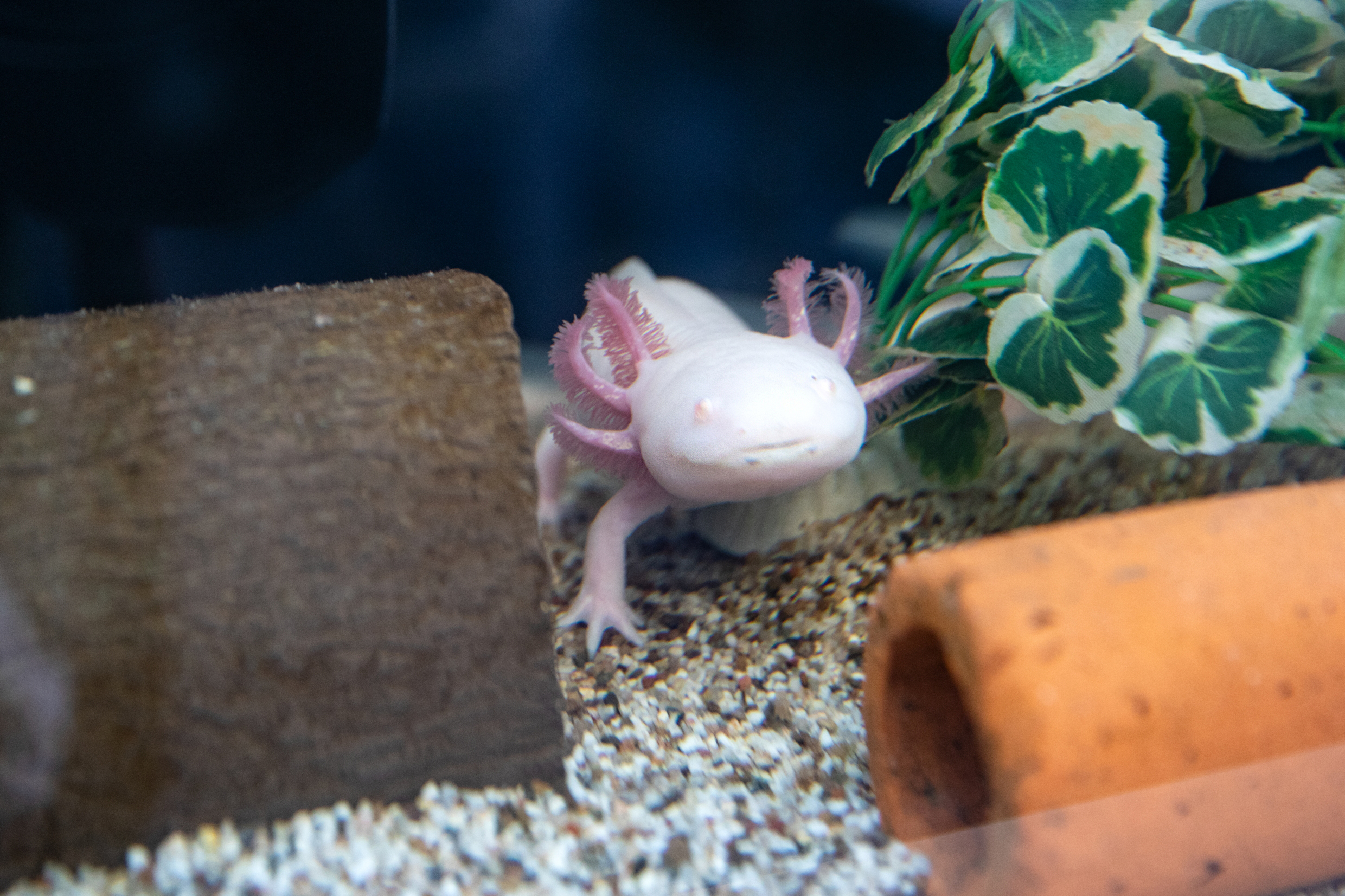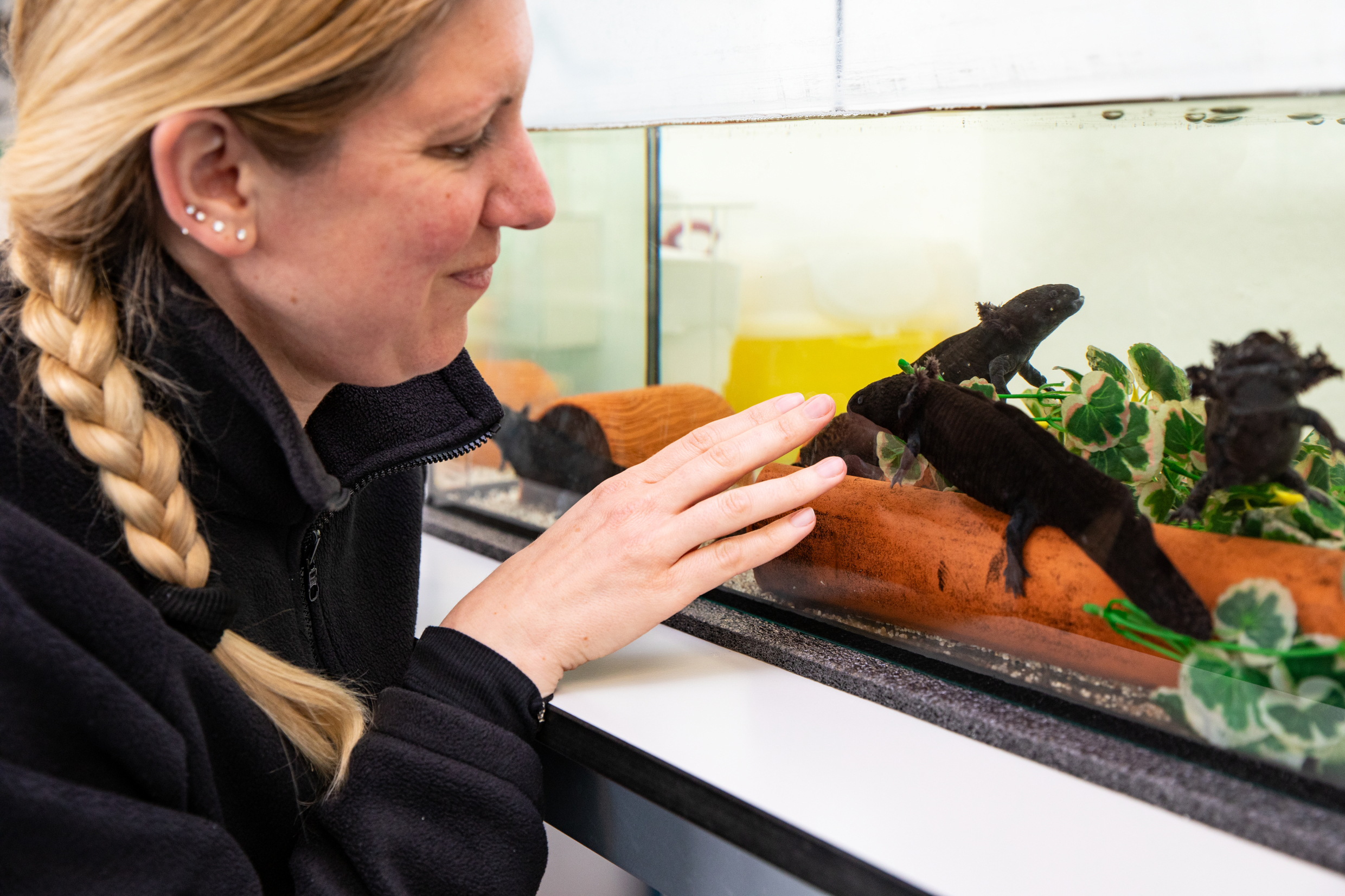MHH researchers find antimicrobial peptides on axolotl skin that not only fight dangerous hospital germs but also tumour cells as an effective antibiotic alternative.

Increasingly interesting for medicine: axolotls. Copyright: Karin Kaiser/MHH

Dr Sarah Strauß has found effective antibiotic alternatives on the skin of the axolotl, which also fight tumour cells. Copyright: Karin Kaiser/MHH
Axolotls are known for their ability to regrow limbs, organs and even parts of the brain and heart. But the tailed amphibian with the scientific name Ambystoma mexicanum can do even more. Its mucous membrane protects it from pathogens, more precisely: the antimicrobial peptides (AMP) it contains. This property makes the amphibian interesting for medicine, as the increasing resistance of bacteria to antibiotics is a major problem in the healthcare sector. Researchers are therefore looking for new target molecules that can replace the increasingly ineffective antibiotics. AMPs are among the most promising candidates. They are part of the innate immune system and are found in almost all living organisms.
A research team led by Dr Sarah Strauß, Head of the Kerstin Reimers Laboratory for Regenerative Biology at the Plastic, Aesthetic, Hand and Reconstructive Surgery at Hannover Medical School (MHH), has studied various AMPs from the skin mucus of axolotls living in the laboratory. The researchers were able to show that the AMPs were not only effective against multi-resistant bacteria such as the dreaded so-called hospital germ MRSA. They were also able to successfully combat cancer cells. The results have been published in the scientific journal ‘Plos one’.
Mucus obtained through gentle massage
"Antimicrobial peptides could be an alternative to antibiotics in the future. They have a broad spectrum of activity and at the same time it is more difficult for pathogens to develop resistance," says Clinic Director Professor Dr Peter M. Vogt. To obtain the skin mucus, the axolotls were gently massaged with sterile gloves and the mucus produced was removed from the gloves with sterile scrapers - all in accordance with the guidelines of the German Animal Welfare Act. In collaboration with the Fraunhofer Institute for Toxicology and Experimental Medicine ITEM in Hanover, 22 likely effective peptide candidates were selected from the thousands of AMPs extracted from the mucus and synthesised. ‘This is time-consuming and expensive, but unfortunately AMPs are not as easy to produce in microorganisms as some antibiotics,’ explains the biologist. The reason for this lies in the chemical structure and mechanism of action of AMPs: they contain amino acids with a positive charge and have water-repellent components. This enables them to bind to the cell wall of bacteria. There they cause small holes or penetrate the cell and bind to molecules. Both damage the cell and lead to death. AMPs can also act against fungi and various viruses.
Effectiveness against MRSA
Dr Strauß suspects that the special chemical structure could contribute to the effectiveness of AMP against resistant bacterial strains and possibly reduce the risk of resistance. This offers medicine a decisive advantage, as the problem of resistance development is increasingly affecting so-called reserve antibiotics. These are used for infections caused by bacteria against which conventional antibiotics are no longer effective, such as methicillin-resistant Staphylococcus aureus (MRSA). ‘Four of our axolotl AMPs showed efficacy against MRSA that was sometimes even better than that of the reserve antibiotic vancomycin,’ says the biologist. ‘The results against MRSA are particularly significant because the spread of this multi-resistant bacterial strain will continue to increase with the overuse of antibiotics in both healthcare and agriculture,’ explains Professor Vogt.
Controlled biological programme
The researchers found an anti-carcinogenic effect with three of the four AMPs, which also exhibited a significant inhibition of MRSA. In cell culture, these triggered what is known as programmed cell death in breast cancer cells: a controlled biological programme in which the affected cell dies. ‘We observed that the peptides specifically kill cancer cells without attacking healthy breast tissue cells,’ emphasises Dr Strauß. ‘Overall, our results suggest that these identified AMPs could be promising candidates for combating antibiotic resistance and for anti-cancer strategies.’ However, further investigations are needed to verify this.
Endangered amphibian species
The axolotl, originally native to Mexico, is now threatened with extinction. The ‘Ambystoma Mexicanum Bioregeneration Centre’ (ABMC) of the Kerstin Reimers Laboratory for Regenerative Biology, founded in 2010, is home to the species Ambystoma mexicanum as well as other amphibian species, some of which are also endangered - all animals come from captive breeding. The AMBC works with international co-operation partners such as universities, private institutes and zoos. It is also a point of contact for veterinarians and offers training and advice as well as practical support on the topics of species-appropriate animal husbandry, diseases, diagnostics, therapy, anaesthesia and surgical techniques.
Text: Kirsten Pötzke